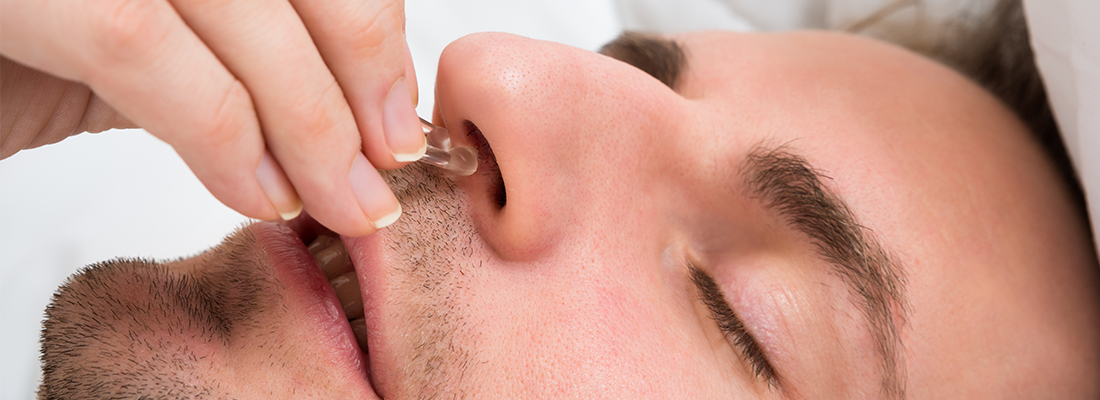As a problem snorer, you may be wondering what kinds of devices are available to help you stop snoring, restore quiet to your bedroom and mend your relationship with your sleeping partner.
So, you’re a problem snorer, mainly during allergy season or if you have a cold, but it really messes with your sleep, and with your domestic tranquility – your bed partner threatens to exile you to the spare room or the couch if you don’t do something about it.
Snoring is a massive social problem, responsible for disharmony in people’s relationships all over the planet. It’s a sleep deprivation problem too, because both the snorer and their sleeping partner are likely to have problems getting enough uninterrupted sleep. The consequences of too little sleep range from daytime fatigue to attention-span problems, to increased likelihood of obesity, to greater danger of auto accident.
The most dangerous consequence of snoring is Obstructive Sleep Apnea (OSA), a medical condition that causes serious health challenges, from blood pressure problems to stroke. If your breathing stops for long periods when you sleep, if you wake up choking, or if you are often so sleepy in the daytime that you can’t function, see a doctor for expert medical appraisal of your condition, and appropriate treatment.
Heavy snorers who don’t have OSA can choose from a bewildering variety of devices that aim to help stop the nightly rumble and rattle. These come in three main types:
Mouthpiece Devices
Mandibular Advancement Devices (MADs) – like the mouth guards worn by athletes, this device fits between your upper and lower jaws. The hinged mouthpiece eases your lower jaw forward to help keep your tongue and soft palate from intruding in your airway when your muscles are relaxed in sleep. Many MAD devices work by restricting mouth breathing, which forces you to inhale and exhale through your nose. As you can guess, wearing a mouthpiece can take some getting used to, and many people can’t manage to make the trade-off: loss of comfort in exchange for a chance to stop snoring. There are dozens of MADs on the market, some of which are fitted by medical professionals, and others that can be shaped by the patient. Here are a few of the MADs on the market: Z-Quiet®; SnoreDoc®; PureSleep®; SnoreRx®; and SomnoGard®.
Tongue Stabilizing Devices (TSDs) – these devices are intended to help with snoring caused by the tongue slipping toward the back of the throat when you’re in your deepest levels of sleep. The involuntary relaxation of muscles in deep sleep leads to snoring because the passage of breath through the narrowed throat causes audible vibration. TSDs are also quite intrusive, and not for everyone. Some of the better-known brands include: Zyppah®; aveoTSD®; and Good Morning Snore Solution.
Nasal Dilators
The name says pretty much what they do: these devices dilate or widen the nasal passages to help increase the volume of air you inhale, and to help relieve the stuffy feeling that interferes with sleep and exercise. There are two main types:
Nose insert – these devices are designed to be inserted into the nostrils; they simply widen the nasal passages, especially the nasal valve, because it’s so near the nostrils, by propping them open. Not the most comfortable way to sleep or exercise, but if it stops the snoring and restores domestic tranquility, well worth it. The Brēz® Nasal Insert and the Max-Air™ Nose Cone® are two examples of inserts.
External Nasal strip – External nasal strips are adhesive-backed, flexible plastic strips that widen the nasal airway from the outside. You simply peel off the backing, and apply the strip to the nose. The plastic strip pulls outward on the skin of the nose, to open up the nostrils in the vicinity of the nasal valve. The biggest brand in the marketplace is the original: Breathe Right® Nasal Strips. Learn more about nasal strips here.
Other Anti-snoring Aids
Chin straps – This somewhat unwieldy appliance has simple purpose: to keep your mouth closed, and your jaw aligned slightly forward while you sleep. It has a stretchy sling fitted to cup your chin, with a Velcro-adjustable band that runs over the crown of your head. There’s a cut-out on each side to keep the strap from squashing your ears. The strap is adjusted to gently hold the chin in place, while allowing enough play so you can drink, and so you won’t feel too restrained. The My Snoring Solution strap and an Anti-Snoring Chin Strap marketed by SnoreDoc are two examples of this approach.
Anti-snore Pillows – Snore-stopping pillows are intended to alter the position of your head while you sleep. This – it’s hoped – avoids a sleeping position, usually flat on your back, that lets your tongue slide toward your throat, and your mouth fall open. There are several different designs, all of which aim to raise your head and shoulders, and cradle your head in a position that promotes unobstructed airways. Some typical approaches are:
- Contour Pillows, which feature a head-and-neck-shaped depression, sometimes made with memory-foam type material. Popular brands include the Snore No More Pillow, and Anti-snore memory foam pillows by Celliant Sleep.
- Wedge Pillows are firm foam triangles, with a flat, fairly steep incline, for elevating the head and shoulders. InteVision markets one popular model.
- Neck Rings attach gently around the sleeper’s neck, to help prevent the head from resting flat on the mattress. The Rakula Anti-snore pillow is one common example.
Tennis Ball Shirt. This may be the strangest idea that really can help you stop snoring: a sleeping shirt with a pocket positioned roughly over the middle of your back. All you do is insert a tennis ball and zip the pocket closed, to keep you from rolling on your back to sleep. There are several small web sites devoted to this simple secret, including one called tennisballtshirt.com (oddly, the tennis ball is not included in your purchase!)

